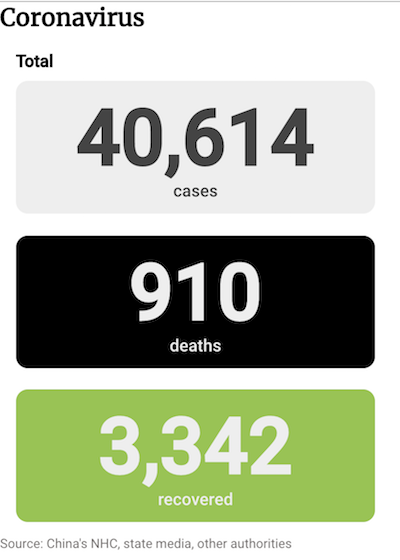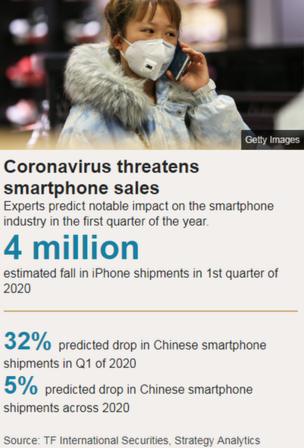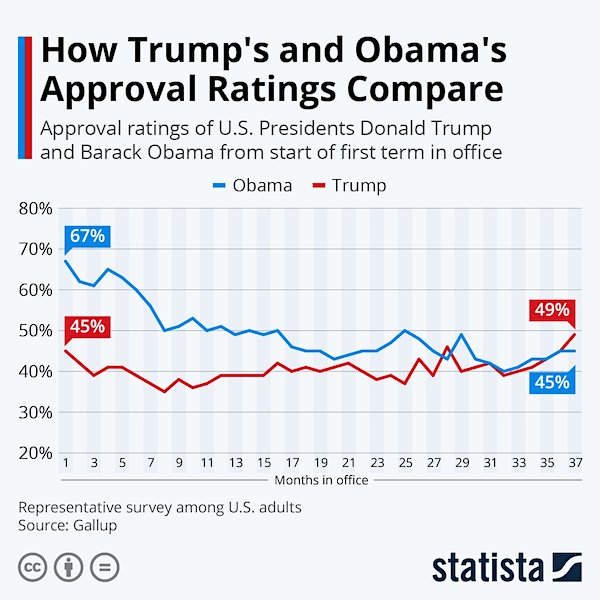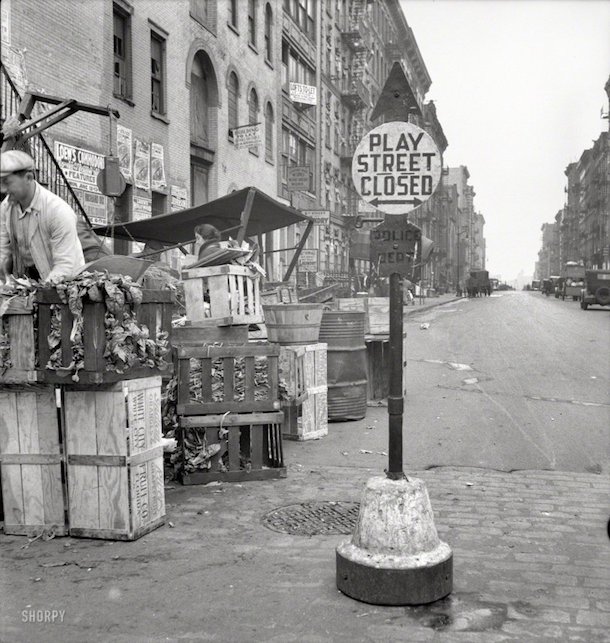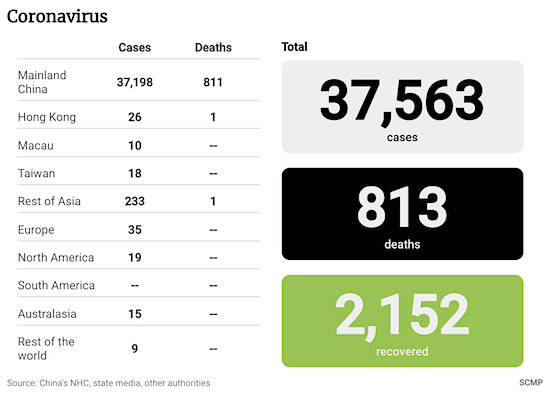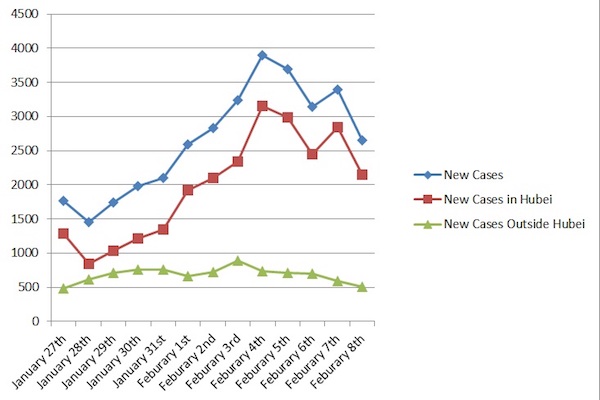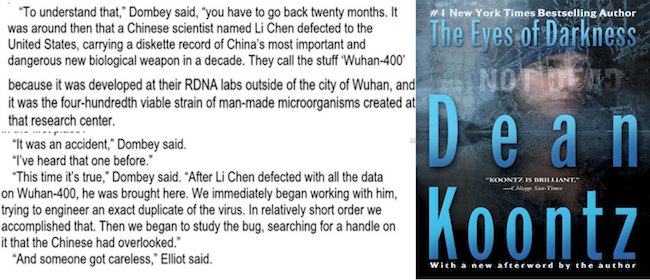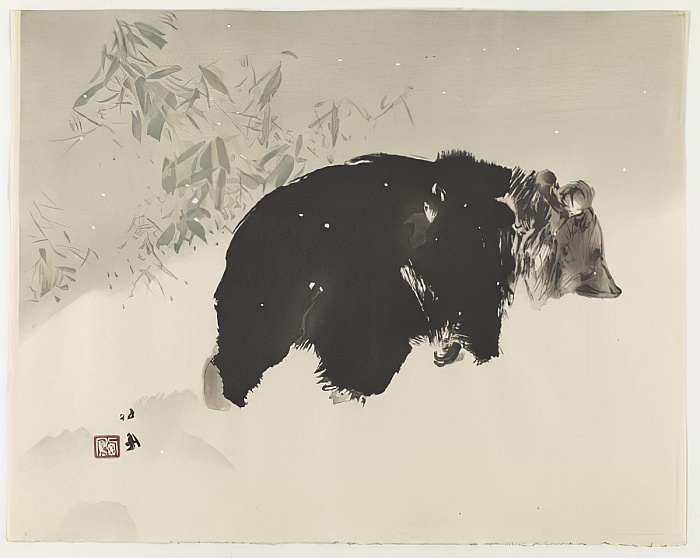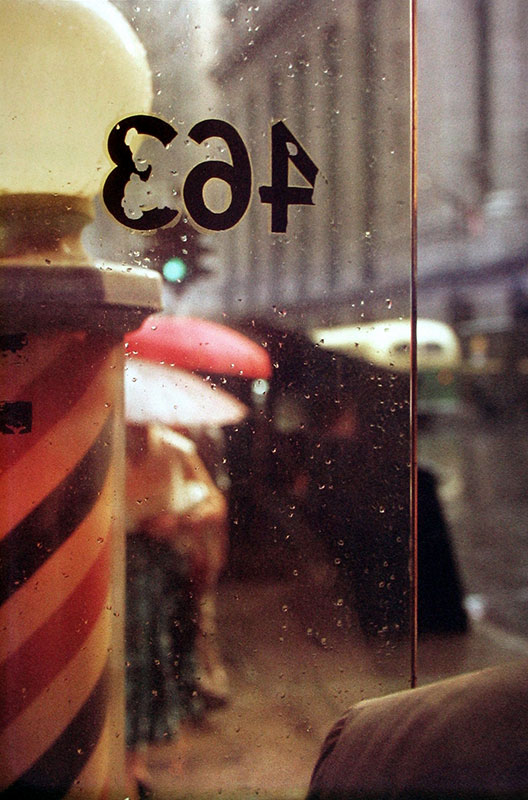
Saul Leiter 463 1956

Major developments today (overnight for many) with regards to the COVID19 coronavirus. Probably not so much in infections or deaths per se (at least not that we know), but in the way(s) cases are reported. Or, if a spade is called a spade, the way they have been severely underreported so far.
What happened is Hubei’s health commission changed the diagnostic criteria used to confirm cases. And that looks something like this:
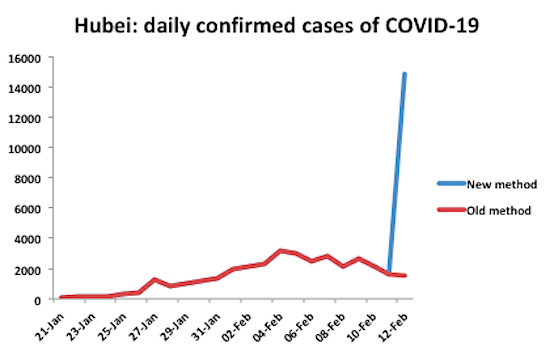
Which leads to this global picture:
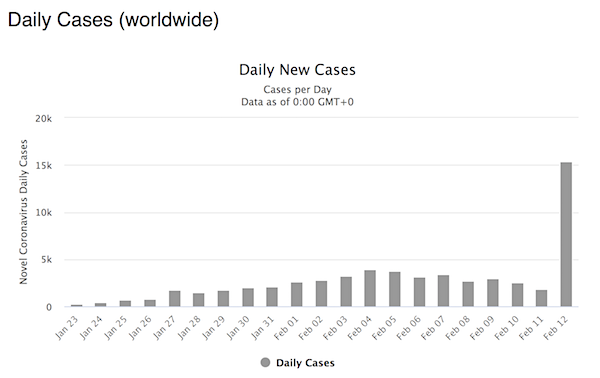
What it comes down to is Hubei used to count cases according to “the old method”, which required clinical diagnosis PLUS testing, and has now switched to “the new method”, in which clinical diagnosis suffices. “Clinically diagnosed cases” here means those cases that show up positive on a CT scan (CT: computed tomography, a way to “look at” internal organs). The changes are in red in the doc:
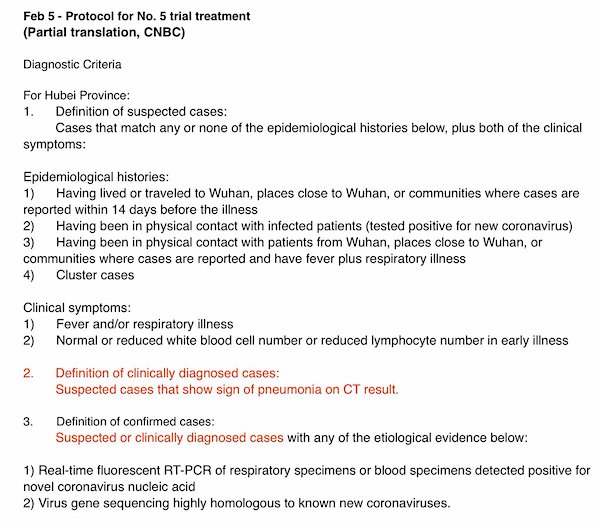
Basically, “showing up positive on a CT scan” refers to the detection of pneumonia. For weeks, officials maintained that in an area under heavy siege of a disease for which pneumonia is one of the main symptoms, additional testing was mandatory to confirm a case as COVID19. Yeah, that’s a little crazy.
Ironically, the WHO went along with these counts based on “the old method”, with its chief effusively praising China for its efforts to combat the virus, but the switch to “the new method” comes just two days after a first team of WHO specialists arrived in China, which will “lay the groundwork for a larger international team.” Looks like Beijing has lost control.
The Party understood that it would no longer be able to keep up appearances, so it fired a whole bunch of politicians (Wuhan Party Chief et al) and other functionaries, appointed others in their place, and now vows a fresh start without the Party being blamed for a thing. And it can say nothing really changed, there is no large amount of additional cases, it’s all just a diagnostic ”tweak”.
Still, this hides the reasons behind the diagnostic changes: China either doesn’t have enough testing kits, or can’t get them out -and used- in the field fast enough. And that means too many potentially infectious patients are out there able to spread the virus. Add the WHO team of specialists to the mix and they chose to do damage control.
Total confirmed and clinically diagnosed #COVID19 cases globally at 60,148. Death toll worldwide 1,365. #China state media count.
— Eunice Yoon (@onlyyoontv) February 13, 2020
All of which leads to these provisionary official numbers:
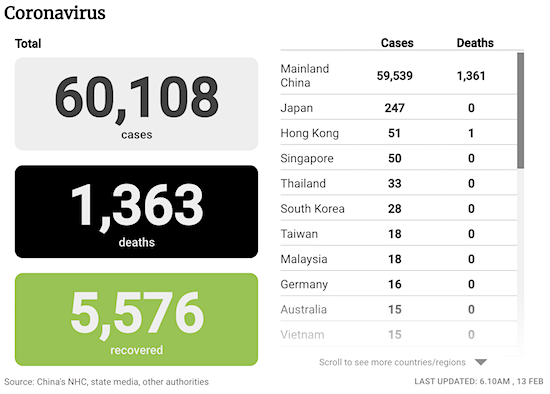
Obviously, this has blown all previously referenced models out of the water.
Even JPMorgan’s most pessimistic case can’t keep up. Everybody needs to go back to the drawing board. And will do so, much more suspicious of anything China says from here on in. Tomorrow’s official numbers are likely to “normalize” again, 2,000 new cases, 90 deaths, that sort of thing. But they will now be reported with big question marks. Still, politicians and media alike, whether in the west or in China, will tell you things are improving. They can’t help themselves. But you can.
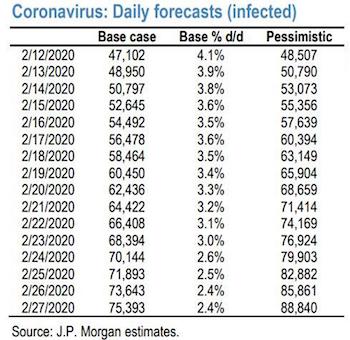
Here are some of the relevant news stories. Regular news in the Automatic Earth Debt Rattle will follow later today.

“Hubei’s new confirmed cases pegged at 14,840, nearly 10 times more than the previous day, while deaths more than doubled to 242.”
Note: that may look like a mortality rate of 20%, but that is far too high. Then again, 2% max doesn’t look tenable anymore either. More on that below.
• Hubei’s Coronavirus Cases Rise 10-Fold After Change In Diagnostic Criteria (SCMP)
Health authorities in China’s Hubei province – the epicentre of the coronavirus epidemic – reported on Thursday 14,840 new confirmed cases, almost 10 times the number reported a day earlier, and new deaths attributable to the contagion rose to 242, more than double on the day. This brings the totals announced by the province’s health commission to 48,206 and 1,310, respectively, as of Wednesday. Officials in Hubei had reported 94 fatalities and 1,638 newly confirmed cases a day earlier. Hubei’s health commission said in its daily statement that it had changed the diagnostic criteria used to confirm cases, effective Thursday, meaning that doctors have broader discretion to determine which patients are infected.
“From today on, we will include the number of clinically diagnosed cases into the number of confirmed cases so that patients could receive timely treatment,” the health authority said. Previously, patients could only be diagnosed by test kits, which has seen a shortage of supply across the country. Tong Zhaohui, an expert in the central guidance group and vice-president of Beijing Chaoyang Hospital, said the move was in line with the National Health Commission’s latest diagnostic guidelines to include clinical diagnosis, using CT scans and other tests. “When doctors diagnose pneumonia, they can only get the etiology of the disease 20 to 30 per cent of the time. We have to rely on clinical diagnosis 70 to 80 per cent of the time. Increasing the diagnosis of clinical cases will help us make an additional judgment on the disease,” he told state broadcaster CCTV in an exclusive interview.
[..] Some 13,436 of the new cases announced on Thursday were confirmed in Hubei’s capital of Wuhan …

The mortality rate looks bad. See more in next article. (h/t Doc Robinson)
• COVID-19 Coronavirus Cases (Worldometer)
There are currently 60,373 confirmed cases and 1,369 deaths from the Wuhan Novel Coronavirus (2019-nCoV) outbreak as of February 13, 2020, 05:20 GMT. The condition of patients, according to the World Health Organization (Feb. 7 press conference) and based on 17,000 cases in China, are: • 82% mild •15% severe •3% critical
“Total Cases” = total cumulative count (60,373). This figure therefore includes deaths and recovered/discharged patients (cases with an outcome). By removing these from the “total cases” figure, we get “currently infected cases” (cases still awaiting for an outcome). The charts include provisional data and values for Feb. 12 that are the result, for the most part, of a change in diagnosis classification, for which an additional 13,332 cases and 107 deaths were counted on Feb. 12..
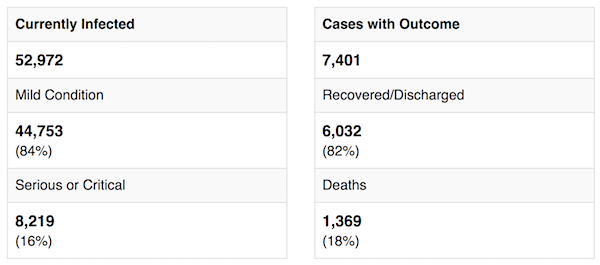

Mortality rate in Hubei/mainland China looks awful at 18%. Is that just because no “light” cases are counted, which the world outside China does seem to do?
• Novel Coronavirus (COVID-19) Mortality Rate (Worldometer)
Let’s take, for example, the data at the end of February 8, 2020: 813 deaths (cumulative total) and 37,552 cases (cumulative total) worldwide. If we use the formula (deaths / cases) we get: 813 / 37,552 = 2.2% CFR (flawed formula). With a conservative estimate of T(ime) = 7 days as the average period from case confirmation to death, we would correct the above formula by using February 1 cumulative cases, which were 14,381, in the denominator: Feb. 8 deaths / Feb. 1 cases = 813 / 14,381 = 5.7% CFR (correct formula, and estimating T=7).
T could be estimated by simply looking at the value of (current total deaths + current total recovered) and pair it with a case total in the past that has the same value. For the above formula, the matching dates would be January 26/27, providing an estimate for T of 12 to 13 days. This method of estimating T uses the same logic of the following method, and therefore will yield the same result. An alternative method, which has the advantage of not having to estimate a variable, and that is mentioned in the American Journal of Epidemiology study cited previously as a simple method that nevertheless could work reasonably well if the hazards of death and recovery at any time t measured from admission to the hospital, conditional on an event occurring at time t, are proportional, would be to use the formula:
CFR (case fatality rate)= deaths / (deaths + recovered) which, with the latest data available, would be equal to: 1,369 / (1,369 + 6,032) = 18% CFR (worldwide) If we now exclude cases in mainland China, using current data on deaths and recovered cases, we get: 2 / (2 + 76) = 2.6% CFR (outside of mainland China) The sample size above is extremely limited, but this discrepancy in mortality rates, if confirmed as the sample grows in size, could be explained with a higher case detection rate outside of China especially with respect to Wuhan, where priority had to be initially placed on severe and critical cases, given the ongoing emergency.
Unreported cases would have the effect of decreasing the denominator and inflating the CFR above its real value. For example, assuming 10,000 total unreported cases in Wuhan and adding them back to the formula, we would get a CFR of 7.9% (quite different from the CFR of 18% based strictly on confirmed cases). Neil Ferguson, a public health expert at Imperial College in the UK, said his “best guess” was that there were 100,000 affected by the virus even though there were only 2,000 confirmed cases at the time. [11] Without going that far, the possibility of a non negligible number of unreported cases in the initial stages of the crisis should be taken into account when trying to calculate the case fatally rate.
With the numbers of people infected with #coronavirus increasing, Professor Neil Ferguson – director of the @MRC_Outbreak at @imperialcollege tells #r4today he feels we’re in the “early phases of a global pandemic”
Read more: https://t.co/Pm7Tggebmd pic.twitter.com/2qoUWl3jUd
— BBC Radio 4 Today (@BBCr4today) February 12, 2020

Ship has 2,600 passengers, 1,100 crew. Only a few hundred have been tested. And we get it, it’s very hard to isolate that many untested people off the ship, where do you get the accomodation.
Now crew members are increasingly getting infected, while attending to the passengers. A crew member told CNN the quality of meals is getting real good, children get new toys every day etc.
The same crew member said she herself waited for 2 days to see a doctor. Crew also don’t have private rooms. They must be very anxious.
• 44 More Cases On Diamond Princess Cruise Ship Anchored Off Japan (SCMP)
Another 44 people on board a cruise ship moored off Japan’s coast have tested positive for the novel coronavirus, the country’s health minister said on Thursday. Health Minister Katsunobu Kato said the 44 new cases were detected from another 221 new tests. They raise the number of infections detected on the Diamond Princess to 218, in addition to a quarantine officer who also tested positive for the virus. Kato said authorities now want to move elderly people off the ship if they test negative for the virus, offering to put them in government-designated lodging. “We wish to start the operation from tomorrow or later,” Kato told reporters.
Of the newly diagnosed infections, 43 are passengers, and one a member of the crew. The Diamond Princess set off from Hong Kong on January 25 for a trip scheduled to end on February 4. Instead, it has been moored off Japan since February 3, after it emerged that a former passenger who disembarked in Hong Kong last month had tested positive for the virus now named Covid-19.

At the WHO, the administrative leadership is miles apart from the medical specialists. The latter are now taking over.
• WHO Team Arrives In China As Wuhan Coronavirus Deaths Top SARS (CNN)
The number of deaths from the Wuhan coronavirus had risen to over 1,000 by Tuesday morning, as experts from the World Health Organization (WHO) arrived in China to assist with controlling the epidemic. Chinese health authorities said 108 people died from the virus in mainland China on Monday, with the majority of those deaths occurring in Hubei province, the capital of which is Wuhan – the city where the virus was first found. The total number of deaths stands at 1,018, all but two of those in mainland China. Globally, 43,114 have now been diagnosed with the virus, again with the majority in China. Around 4,000 patients have been treated and released from hospital in China since late December.
A team of World Health Organization (WHO) experts landed in China on Monday. The organization’s director general, Tedros Adhanom Ghebreyesus, said they will “lay the groundwork for a larger international team,” which will join them “as soon as possible.” The WHO group in China is led by Bruce Aylward, who helmed the body’s response to Ebola, as well as initiatives for immunization, communicable diseases control and polio eradication. Their arrival comes as the WHO is facing increasing criticism for its initial decision not to declare a global health emergency, and for officials’ effusive praise of China’s handling of the crisis, even as Beijing faces outrage domestically for, among other things, the death of whistleblower doctor Li Wenliang, and the subsequent censorship of that news.

Spring cleaning.
• Beijing’s Purge Over Virus Takes Down Top Communist Party Officials In Hubei (SCMP)
Beijing’s purge of officials in Hubei province picked up pace with the removal of the top Communist Party leaders in the region as the central government responded to public anger over what is seen as a botched response to the deadly coronavirus outbreak in the region. China’s official Xinhua news agency reported that Hubei party secretary Jiang Chaoliang will be replaced by Shanghai Mayor Ying Yong, 61, a close ally of Chinese President Xi Jinping. The Communist Party leader of Wuhan city Ma Guoqiang, 56, is also set to be dismissed, according to a person familiar with the development who was not authorised to speak on the issue. Ma will be replaced by Wang Zhonglin, 57, party secretary of Shandong’s provincial capital Jinan.
Jiang, 61, is the highest-ranking political casualty so far in the outbreak, which has killed more than 1,100 people in mainland China, the vast majority in Hubei and its capital, Wuhan city. As details have trickled out on how local officials mismanaged the outbreak, public anger has swelled on social media. Academics have also signed a public petition to demand free speech after the police punished doctors who raised the early alarm about the outbreak. “Sending Ying Yong and Wang Zhonglin to Hubei shows the central government is determined to fix Hubei and give people answers. The cadres there have been really disappointing,” the unnamed person said. “The outbreak cost the party dearly. Those who are responsible will be held accountable.”

“Then on day 8, the reporters saw their first dead body in the street. He’s a man, in his sixties, who is lying on his back in front of a closed furniture store. Officials in hazard suits slowly approach the body, taking every conceivable precaution.”
• Botched Wuhan Quarantine Left Dead Bodies In The Street (ZH)
[..] few have captured the atmosphere of the situation quite like a team of AFP journalists who lingered in Wuhan after the lockdown, and have detailed their experiences in diary format. The diary begins on Jan. 23, the day Wuhan was placed under lockdown. It starts as one might expect: Though the news was a shock, few tried to escape the city before the lockdown officially went into effect. Police chase the last travelers out of the railroad station. But the situation doesn’t really start to escalate until Jan. 25, or New Year’s Day in China. Those who went to worship at the city’s Guiyan temple, normally packed this time of year, found it empty: nobody was allowed inside.
“No-one is allowed inside in order to prevent the virus spreading,” a uniformed man – who is not wearing the compulsory mask – tells AFP. On the fourth day of the crackdown, conditions in Wuhan really started to deteriorate. This marked the beginning of hard times for Wuhan. Overwhelmed hospitals arbitrarily turned people away if their swab tests came back negative for the virus. One man told an AFP reporter that he had been turned away by four hospitals, despite being seriously ill. “I haven’t slept,” he said. He was getting ready to wait in line all night to hopefully be admitted to another hospital. For the first in their memory, the AFP reporters said Chinese out on the streets approached them to complain about the government’s handling of the lockdown.
“Like a horror film,” says one witness, who tells AFP bodies were left unattended for hours. [..] On day 6, the AFP spoke to a French doctor who had decided to stay in Wuhan, a Dr. Philippe Klein. “It’s not an act of heroism,” he said. “It’s been well thought out, it’s my job.” More signs of the government crackdown are beginning to appear: Guards take the temperature of customers at supermarkets and other stores hawking essential goods. Then on day 8, the reporters saw their first dead body in the street. He’s a man, in his sixties, who is lying on his back in front of a closed furniture store. Officials in hazard suits slowly approach the body, taking every conceivable precaution.

Well, you can’t say I didn’t warn you. This is precisely what I warned about. And the new numbers will do nothing to restore any confidence at all.
• What Happened After One Chinese Company Reopened After The Corona-Chaos (ZH)
Today, two days after China officially returned to work, we got the first confirmation of just how catastrophic Beijing’s order to local enterprises and businesses to rush back reboot the economy could be, when Jennifer Zeng reported that a company in Suzhou reopened, and immediately at least one CoVid2019 case found. As a result, the company’s 200+ employees couldn’t go home and were immediately placed under quarantine. At least the workers managed to “organize” quilts for themselves. This is just the first such case. Expect many more – especially across Hubei and its neighboring provinces – as latent cases of Coronavirus which were never caught and cured spark new infections and mini epidemics, all of which dutifully captured on a smartphone clip for everyone in China to watch and freak out even more.
Which reminds us of another comment from Rabobank, which last week explained why the dilemma facing China is “truly awful”: The quandary for China between releasing the quarantine straitjacket in days to stop its economy from getting truly sick, and allowing a virus like this to spread further as people start to mingle again is truly awful. There are no good options. For a world with a serious lack of final end-demand, and which has been relying on China, along with increasingly “Chinese” central banks, this is going to be a nasty shock either way that Mr Market is treating like he is Mr Magoo.
And since Beijing has no way out, especially since the epidemic is still raging despite Beijing’s “doctored”, no pun intended, infection and death numbers, expect China to unleash the most draconian censorship crackdown on any reports Covid-2019 has not only not been purged but is making unwelcome appearances across China’s enterprises, which will be quietly put under blanket quarantine even as Beijing pretends that all is well and its economy is once again humming on all cylinders until eventually the epidemic reaches a critical mass and China has no choice but to once again admit the full extent of the social and economic fallout. And just like in the case of SARS, don’t expect such “honesty” to emerge for at least several weeks if not months.

“The city governments of Zhongshan and Foshan in Guangzhou province have postponed the resumption of work until March 1, while companies must apply for special permission in Hangzhou, the capital of Zhejiang province. The local administration has so far only given the green light to 1,462 out of nearly 30,000 companies based in the city”
Will these party officials be fired for being too strict?
• China Struggles To Balance Coronavirus Containment With Economic Cost (SCMP)
To work or not to work – that is proving a crucial question for Chinese officials, companies and employees as the world’s second largest economy struggles to balance the risk of the deadly coronavirus with the need to resume business. Most provinces across China restarted operations on Monday after an extended Lunar New Year holiday, but an influx of workers returning from their hometowns is posing a headache for authorities. The coronavirus, which has killed more than 1,100 people and infected nearly 45,000, shows few signs of being contained, stoking fears of a potential spike in infections as people return to work. While the central government has made it clear that containing the outbreak is an overriding priority, Communist Party leaders know they cannot afford to freeze industrial production indefinitely, especially as China’s economy grows at its slowest pace in decades.
[..] As the virus has spread from Hubei’s provincial capital Wuhan, authorities across China have imposed travel restrictions, cancelled public events and locked down neighbourhoods. Last week, the government of Suzhou, a major manufacturing hub in Jiangsu province, which is known for its silk products, asked local communities to tell workers from Hubei and Zhejiang provinces not to return until further notice. This employee “blacklisting” was echoed by other cities, including Wuxi in the south of Jiangsu, which banned migrant workers from at least seven provinces. While most provincial level governments have urged companies to resume operations this week, officials at local levels are dragging their feet.
The city governments of Zhongshan and Foshan in Guangzhou province have postponed the resumption of work until March 1, while companies must apply for special permission in Hangzhou, the capital of Zhejiang province. Once approved, employees are required to report their body temperatures to local authorities daily. The local administration has so far only given the green light to 1,462 out of nearly 30,000 companies based in the city, an approval rate below 5 per cent. Small and medium-sized enterprises in China, which are a cornerstone for employment and social stability, are at most risk from the efforts to contain the outbreak. A recent survey conducted by researchers from Tsinghua and Peking universities in Beijing, two of China’s top institutions of higher learning, found that 67.1 per cent of small and medium-sized enterprises had only enough financial reserves to sustain operations for two months if revenues dried up. The survey of 995 companies also found that 30 per cent expected revenues to shrink by at least half from 2019.

In case the virus didn’t scare you enough:
“80 percent of the U.S. supply of antibiotics are made in China…”
• Protecting The US From Global Pandemics (Scott Gottlieb)
About 40 percent of generic drugs sold in the U.S. have only a single manufacturer. A significant supply chain disruption could cause shortages for some or many of these products. Last year, manufacturing of intermediate or finished goods in China, as well as pharmaceutical source material, accounted for 95 percent of U.S. imports of ibuprofen, 91 percent of U.S. imports of hydrocortisone, 70 percent of U.S. imports of acetaminophen, 40 to 45 percent of U.S. imports of penicillin, and 40 percent of U.S. imports of heparin, according to the Commerce Department. In total, 80 percent of the U.S. supply of antibiotics are made in China.
While much of the fill finishing work (the actual formulation of finished drug capsules and tablets) is done outside China (and often in India) the starting and intermediate chemicals are often sourced in China. Moreover, the U.S. generic drug industry can no longer produce certain critical medicines such as penicillin and doxycycline without these chemical components.iv According to a report from the US-China Economic and Security Review Commission, China’s chemical industry, which accounts for 40 percent of global chemical industry revenue, provides a large number of ingredients for drug products.
It’s these source materials – where in many cases China is the exclusive source of the chemical ingredients used for the manufacture of a drug product – that create choke points in the global supply chain for critical medicines. Moreover, when it comes to starting material for the manufacture of pharmaceutical ingredients, a lot of this production is centered in China’s Hubei Provence, the epicenter of coronavirus. Most drug makers have a one to three-months of inventory of drug ingredients on hand. But these supplies are already being drawn down. Among big API makers in Wuhan are Wuhan Shiji Pharmaceutical, Chemwerth, Hubei Biocause, Wuhan Calmland Pharmaceuticals.
[..] We’re facing the potential for unprecedented supply chain disruptions. You can’t easily switch component part suppliers — either starter material for the manufacture of drugs or components for device devices. You have to qualify those alternative sources, make sure they meet regulatory standards for Good Manufacturing Practices (GMPs), and meet the conditions set by those incorporating these materials into their finished goods. Even if FDA is able to offer manufacturers flexibility in making these component changes, substitutions are often complex.

Some people are just not all that smart.
• South Korea’s Moon Says Virus Epidemic To End Soon (YNA)
President Moon Jae-in expressed confidence Thursday that South Korea will soon bring the novel coronavirus pandemic under control and stressed it is time to resume full-scale efforts to revitalize the economy, meeting with a group of local business leaders. “COVID-19 will be terminated (in South Korea) before long,” he said, using the official name of the disease, during the session held at the Korea Chamber of Commerce and Industry (KCCI) in Seoul. Fortunately, he said, domestic quarantine management “appears to have entered a stable stage to some extent,” although it is still too early to be complacent. He emphasized that quarantine authorities here would continue their efforts “until the end” to contain the virus.
The president voiced regret once again over the outbreak’s negative impact on the country’s economy, which he said had been showing clear indications of recovery. “It’s very regrettable that the ankle of the economy has been seized by the occurrence of the COVID-19 incident,” Moon told the attendees including Samsung Electronics Vice Chairman Lee Jae-yong, SK Group Chairman Chey Tae-won, CJ Group Chairman Lee Jae-hyun and Park Yong-maan, chairman of the KCCI. “Now, it’s time for the government and business circles to join forces and revive the recovery trend of the economy,” Moon said. He reaffirmed the government’s resolve to ramp up its bid to create more jobs with massive investment projects and support private firms with “bold” tax incentives and regulatory reform.

And here’s for the morally challenged. If it won’t make us rich, we should we develop a vaccine?
• Epidemics Are Tough To Turn Into Profit (R.)
Epidemics are catastrophic for humans, and it turns out they aren’t much better for healthcare companies. The number of confirmed cases of the new coronavirus has multiplied more than 80-fold over three weeks despite measures such as travel bans, and exceeded 45,000 across 26 countries on Wednesday, according to researchers at Johns Hopkins University. Tests and treatments are in demand. Yet past events like SARS show slow research, high production costs and political pressure on pricing often add up to disappointing returns. Tests for the virus now called SARS-CoV-2 are here. These are vital for diagnosing, isolating carriers, and tracking exposure.
Meridian Bioscience saw its stock pop on news it had developed a test, but the shares then dropped as investors realized Roche, Qiagen and others would all fight for thin margins. So far, none of the stocks has moved much. A treatment has better profit potential, as competition probably will be limited. The snag is, proving a drug’s effectiveness typically takes years. There are already multiple trials started using existing anti-viral treatments, and potential new drugs by Gilead Sciences and Regeneron Pharmaceuticals have begun testing, or will soon. Even if one company hits the jackpot, production can be a problem. Flu fears in 2009 made Roche’s Tamiflu a blockbuster. But securing enough production of spice star anise to make the drug proved troublesome.
The best long-term hope for coronavirus control is a vaccine. Old-school giant Novartis, biotechnology outfit Moderna and others want to make one. But drug development is hard, and vaccines can be particularly tricky due to viral mutation. World Health Organization chief Tedros Adhanom Ghebreyesus said on Tuesday a vaccine might be available in 18 months, a long way off even assuming no hiccups. Vaccines can be profitable for endemic diseases – Pfizer sold $1.6 billion of a pneumonia vaccine last year. But the outbreak of Severe Acute Respiratory Syndrome in 2003 flared up and hasn’t been seen in humans since. SARS-CoV-2 might follow the same path.



The Automatic Earth will not survive without your Paypal and Patreon donations. Please support us.



